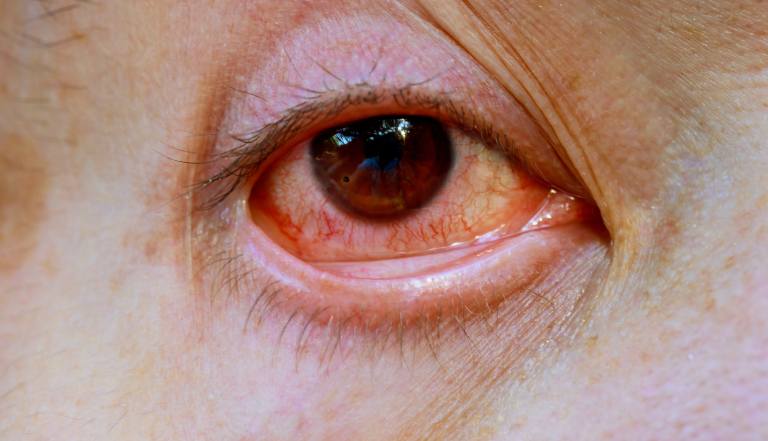Imagine looking into the mirror and finding red, watery eyes staring back at you. It hurts really bad, and your vision is somewhat blurry. You think, “Maybe it’s just fatigue”, but then it hits you: You might have pink eye.
Wait, a pink eye? What’s that? Find out in this blog. We will also explore what causes pink eye and how you can treat it.
What is Pink Eye?
Pink eye, commonly called Conjunctivitis, is a fairly common eye condition that can affect individuals of any age. Just like the name sounds, having a pink eye can make the sclera (the white in your eye) appear reddish or pink. Your eyelids may appear droopy, and it’s common to have discharge from your infected eyes.
Moreover, it can be short-term, lasting less than 4 weeks or long-term if it extends beyond 4 weeks. Plus, it can affect one or both eyes.
What Causes Pink Eyes?
Several factors lead to Conjunctivitis and eye treatments are done based on these 3 categories:
1. Viral Conjunctivitis
Viruses, especially the adenovirus family, are the most common cause of acute conjunctivitis. This family causes respiratory infections similar to colds or flu.
Some of the other viruses that can leave you with pink eyes include the following:
- Measles or mumps
- Eye herpes virus
- Enteroviruses or coxsackieviruses (Better known for causing hand, foot and mouth disease). It is an uncommon occurrence.
2. Bacterial Conjunctivitis
Bacteria rank second on the list of causes. And there are quite a few common ones —
- Staphylococcus
- Streptococcus (causes strep throat)
- Haemophilus influenzae (popular reason behind meningitis in young children)
- Sexually transmitted infections (STIs), like chlamydia, gonorrhea and syphilis (causes neonatal Conjunctivitis, which may lead to permanent damage and blindness)
3. Allergic Conjunctivitis
This type occurs when the eye reacts to allergens like pollen, dust mites, or pet dander. It’s not contagious and often occurs seasonally. Symptoms include intense itching, redness, and watery discharge in both eyes.
Also Read: How to Prevent and Treat Styes: A Complete Guide
Infectious and Noninfectious Conjunctivitis
Infectious Conjunctivitis means that the pink eye is contagious and can spread to other people or the unaffected eye. It comes in four sub-categories: viral, bacterial, fungal, and parasitic. The first 2 are covered above, while the latter 2 are generally rare.
The third cause discussed above, allergic Conjunctivitis, is a form of noninfectious Conjunctivitis. Besides allergens, even irritants and toxic substances like cosmetics, pool chlorine, and contact lenses cause Conjunctivitis.
Identifying Conjunctivitis
Despite differences in causes, the symptoms of Conjunctivitis can often look similar. Thus, it is wise to check for the following signs and symptoms to reach out to your doctor at the right time:
- Redness in one or both eyes
- Itching or burning sensation
- Watery or thick discharge from the eye
- Swollen eyelids
- Sensitivity to light
- A gritty feeling in the eye
- Crusting of the eyelids or lashes, especially after sleep
Pink Eye (Conjunctivitis) Treatment
1. Viral Pink Eye
Most of these cases are mild and usually clear up within one to two weeks. In some cases, it may take 2-3 weeks. To treat viral pink eye, the doctor may recommend:
- Lubricating eye drops
- Antiviral medication for more serious forms
2. Bacterial Conjunctivitis
This type of Conjunctivitis clears up within 2-5 days. However, it can take 2 weeks to go away completely. The treatment options remain more or less the same.
- Antibiotics (especially if there’s discharge, weak immune system, or certain bacteria)
- Ointments
- Eye drops
Additionally, you should:
- Clean the eyes gently with a warm, damp cloth to remove discharge.
- Avoid using contact lenses until the infection is completely gone.
- Dispose of or disinfect any objects that come in contact with the infected eye, like towels or pillowcases.
3. Allergic Conjunctivitis
The simplest way to treat this type is to get rid of the allergen itself. Furthermore, certain eye drops and combinations of medicines will help. Artificial tears can help rinse out the allergen while moisturizing your eye.
Also Read: Seasonal Allergies and Eye Health: How to Manage Symptoms
Wrapping Up
Whether it’s the relentless itching, the sticky discharge that glues your eyelids together, or the unsightly redness that draws curious looks, pink eyes are never fun to deal with.
The good news is that understanding what causes it and knowing how to treat it can significantly reduce your discomfort and stop it from spreading to others. So, if you see any of the signs and symptoms, especially red, watery eyes, it is time to book your appointment with the eye specialist at Shree Ramkrishna Netralaya, one of the best eye hospitals in Mumbai before the concern worsens.

